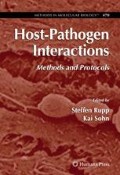Abstract
Adhesion to host tissue represents one of the first steps during the early phase of fungal infections. In order to mediate pathogenesis in the infected host, this process is crucial for colonization and subsequent penetration of the respective tissue. In vivo analyses of the adhesion process in whole organisms are limited because of difficulties in providing reproducible and comparable conditions in the host environment. Therefore, in vitro assays provide the opportunity to study such processes under more defined conditions thus allowing for the analysis of events that are involved in more detail. Here we describe an in vitro adhesion assay making use of human epithelial cell lines to study fungal associations with host epithelia. This assay not only is suited to determine the rate of adhesion in a time-dependent manner but also facilitates global transcriptional profiling in order to determine the fungal response during adhesion at the molecular level.
Access this chapter
Tax calculation will be finalised at checkout
Purchases are for personal use only
References
Moye-Rowley W.S. (2002) Transcription factors regulating the response to oxidative stress in yeast. Antioxid Redox Signal 4, 123–140.
Mendes-Giannini M.J., Soares C.P., da Silva J.L., Andreotti P.F. (2005) Interaction of pathogenic fungi with host cells: Molecular and cellular approaches. FEMS Immunol Med Microbiol 45, 383–394.
Dieterich C., Schandar M., Noll M., Johannes F.J., Brunner H., Graeve T., Rupp S. (2002) In vitro reconstructed human epithelia reveal contributions of Candida albicans EFG1 and CPH1 to adhesion and invasion. Microbiology 148, 497–506.
Sohn K., Senyurek I., Fertey J., Konigsdorfer A., Joffroy C., Hauser N., Zelt G., Brunner H., Rupp S. (2006) An in vitro assay to study the transcriptional response during adherence of Candida albicans to different human epithelia. FEMS Yeast Res 6, 1085–1093.
Wiesner S.M., Bendel C.M., Hess D.J., Erlandsen S.L., Wells C.L. (2002) Adherence of yeast and filamentous forms of Candida albicans to cultured enterocytes. Crit Care Med 30, 677–683.
Hoyer L.L. (2001) The ALS gene family of Candida albicans. Trends Microbiol 9, 176–180.
Sundstrom P. (1999) Adhesins in Candida albicans. Curr Opin Microbiol 2, 353–357.
Staab J.F., Bradway S.D., Fidel P.L., Sundstrom P. (1999) Adhesive and mammalian transglutaminase substrate properties of Candida albicans Hwp1. Science 283, 1535–1538.
Nobile C.J., Nett J.E., Andes D.R., Mitchell A.P. (2006) Function of Candida albicans adhesin Hwp1 in biofilm formation. Eukaryot Cell 5, 1604–1610.
Darfeuille-Michaud A., Aubel D., Chauviere G., Rich C., Bourges M., Servin A., Joly B. (1990) Adhesion of enterotoxigenic Escherichia coli to the human colon carcinoma cell line Caco-2 in culture. Infect Immun 58, 893–902.
Rigothier M.C., Coconnier M.H., Servin A.L., Gayral P. (1991) A new in vitro model of Entamoeba histolytica adhesion, using the human colon carcinoma cell line Caco-2: scanning electron microscopic study. Infect Immun 59, 4142–4146.
Fogh J., Fogh J.M., Orfeo T. (1977) One hundred and twenty-seven cultured human tumor cell lines producing tumors in nude mice. J Natl Cancer Inst 59, 221–226.
Hidalgo I.J., Raub T.J., Borchardt R.T. (1989) Characterization of the human colon carcinoma cell line (Caco-2) as a model system for intestinal epithelial permeability. Gastroenterology 96, 736–749.
Giard D.J., Aaronson S.A., Todaro G.J., Arnstein P., Kersey J.H., Dosik H., Parks W.P. (1973) In vitro cultivation of human tumors: establishment of cell lines derived from a series of solid tumors. J Natl Cancer Inst 51, 1417–1423.
Author information
Authors and Affiliations
Editor information
Editors and Affiliations
Rights and permissions
Copyright information
© 2009 Humana Press, a part of Springer Science+Business Media, LLC
About this protocol
Cite this protocol
Sohn, K., Rupp, S. (2009). Human Epithelial Model Systems for the Study of Candida Infections In Vitro: Part I. Adhesion to Epithelial Models. In: Rupp, S., Sohn, K. (eds) Host-Pathogen Interactions. Methods in Molecular Biology, vol 470. Humana Press. https://doi.org/10.1007/978-1-59745-204-5_9
Download citation
DOI: https://doi.org/10.1007/978-1-59745-204-5_9
Publisher Name: Humana Press
Print ISBN: 978-1-58829-886-7
Online ISBN: 978-1-59745-204-5
eBook Packages: Springer Protocols

